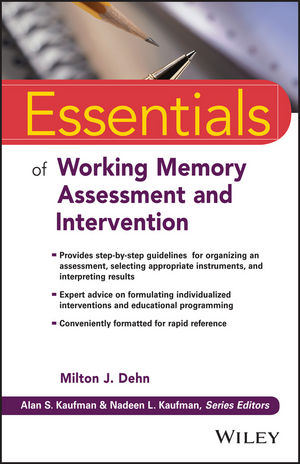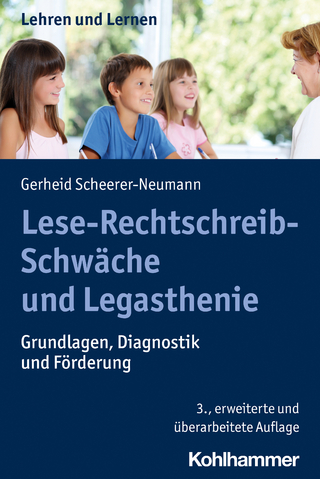
Essentials of Working Memory Assessment and Intervention
John Wiley & Sons Inc (Verlag)
978-1-118-63813-2 (ISBN)
Improve academic learning outcomes with accurate working memory assessment and evidence-based interventions Essentials of Working Memory Assessment and Intervention is an accessible, practical guide to accurately and efficiently assessing working memory. This comprehensive resource explains the theories of working memory, with an emphasis on cognitive load theory, and provides step-by-step guidelines for organizing a cross-battery assessment, selecting appropriate instruments, interpreting results, and formulating individualized interventions and educational programming. In-depth case studies illustrate typical profiles found in children and adolescents with working memory deficits, and the companion CD features worksheets, testing charts, and other useful resources. Reader-friendly design elements including Rapid Reference, Caution, and Don't Forget boxes, and practice questions, bullet points, and icons make this guide useful for both study and desk reference.
Working memory deficits are the main reason why students with disabilities are unable to successfully respond to regular education interventions. Given the strong relationship between working memory and all areas of academic learning, a deeper understanding of working memory and the related assessments and interventions can facilitate greater achievement. This book helps readers:
Understand the development and neuroanatomy of working memory
Learn techniques for improving working memory in the classroom
Examine strategies for brain-based working memory training
Effectively utilize working memory assessment measures
By examining the critical functions of working memory and its relationship with specific learning disabilities, then providing strategies for assessment and detailed intervention guidance, this book helps educatorsand professionals guide their students and clients toward improved cognitive functioning, , reduced frustration, and improved academic performance . For those seeking a practical approach to working memory, Essentials of Working Memory Assessment and Intervention provides the tools and information they need.
MILTON J. DEHN, Ed.D., NCSP, is the cofounder and program director of Schoolhouse Tutoring® and a former practicing school psychologist, associate professor, and director of a graduate training program in school psychology. He is the author of Working Memory and Academic Learning, Long-Term Memory Problems in Children and Adolescents, and Essentials of Processing Assessment, Second Edition all from Wiley.
Series Preface xiii
Acknowledgments xv
One Working Memory Models 1
Working Memory's Influence 2
Baddeley's Working Memory Model 3
Other Models of Working Memory 7
The Controversy Regarding Working Memory Capacity 12
Retention Intervals 15
Cognitive LoadTheory 15
The Integrated Model of Working Memory 16
Two Cognitive Processes Highly Related With Working Memory 25
General Intelligence 26
Fluid Reasoning 28
The Big Three 30
Executive Functions 30
Attention 31
Attention-Deficit/Hyperactivity Disorder 32
Oral Language 34
Auditory Processing 35
Phonological Processing 35
Processing Speed 36
Visual-Spatial Processing 37
Sequential Processing 37
Long-Term Memory 38
Metamemory 42
Strategies 43
Three Development, Neuroanatomy, and Risk Factors 45
Development of Working Memory 45
Metamemory Development 50
Long-Term Memory Development 51
The Neuroanatomy of Working Memory 51
The Neuroanatomy of Long-Term Memory 56
Risk Factors for Working Memory Impairments 58
Four Working Memory's Influence on Academic Learning and Performance 64
Working Memory and Classroom Learning 65
Cognitive Load in the Classroom 66
Working Memory and Basic Reading Skills 69
Working Memory and Reading Comprehension 72
Working Memory and Mathematics 75
Working Memory and Written Expression 81
Working Memory and Oral Language 82
Working Memory and Scholastic Performance 84
Working Memory and LD 85
The Importance of Automaticity 89
Implications for Assessment 90
Conclusions 91
Five Assessment Strategies 95
How to Determine Which Working Memory Component a Subtest Measures 96
Informal Assessment Procedures 102
Assessing Interaction With Long-Term Memory 114
Working Memory Testing 116
Testing Related Cognitive Processes 122
Analyzing Test Results 122
Interpretation of Working Memory Assessment Data 132
Specific Learning Disability Determination 137
Memory Processes Analyzer 138
Six Psychological Scales That Measure Working Memory 141
Child and Adolescent Memory Profile (CHAMP) 143
Cognitive Assessment System, Second Edition (CAS-II) 143
Comprehensive Test of Phonological Processing, Second Edition (CTOPP2) 145
Differential Ability Scales, Second Edition (DAS-II) 146
Kaufman Assessment Battery for Children, Second Edition (KABC-II) 148
The NEPSY II 149
Stanford-Binet Intelligence Scales, Fifth Edition (SB5) 151
Test of Auditory Processing Skills, Third Edition (TAPS-3) 152
Test of Memory and Learning, Second Edition (TOMAL-2) 153
The Wechsler Intelligence Scales 155
WISC-IV Integrated 158
WechslerMemory Scale, Fourth Edition (WMS-IV) 159
Wide Range Assessment of Memory and Learning, Second Edition (WRAML2) 161
Woodcock-Johnson IV Tests of Achievement (WJ IV ACH) 163
Woodcock-Johnson IV Tests of Cognitive Abilities (WJ IV COG) 163
Woodcock-Johnson IV Tests of Oral Language (WJ IV OL) 165
Seven Working Memory Interventions That Change the Brain 168
Types of Working Memory Interventions 169
Selecting Working Memory Exercises and Strategies 169
Measuring Progress 175
Metamemory Training 177
The Efficacy of Working Memory Training 177
How Working Memory Training Changes the Brain 181
Conclusions Regarding the Efficacy of Working Memory Training 183
Internet-Based Working Memory Training 184
Hands-On Working Memory Exercises 188
Interventions That Improve Related Cognitive Processes 192
Eight Supporting Working Memory in the Classroom 197
The Mnemonic-Based Classroom 198
Metamemory Instruction 200
Instruction That Reduces Cognitive Load 201
Accommodations and Modifications for Specific Academic Subjects 205
General Accommodations 208
Instructional Practices That Support Working Memory 209
Teaching Working Memory Strategies 213
Bypassing Working Memory by Using LTM Strategies 222
Nine Case Study 225
Working Memory Interpretation Section 225
Case Study Assessment 227
Example of a Written Interpretation 236
Jon's Interventions 241
Appendix A Scaled Score to Standard Score Conversion Table With Percentiles 253
Appendix B T-Score to Standard Score Conversion Table 256
Appendix C Working Memory Composites and Subtests Sorted by Scale 259
Annotated Bibliography 266
References 269
About the Author 303
About the Online Resources 304
Index 307
| Reihe/Serie | Essentials of Psychological Assessment |
|---|---|
| Mitarbeit |
Herausgeber (Serie): Alan S. Kaufman, Nadeen L. Kaufman |
| Verlagsort | New York |
| Sprache | englisch |
| Maße | 140 x 213 mm |
| Gewicht | 340 g |
| Themenwelt | Geisteswissenschaften ► Psychologie ► Pädagogische Psychologie |
| ISBN-10 | 1-118-63813-1 / 1118638131 |
| ISBN-13 | 978-1-118-63813-2 / 9781118638132 |
| Zustand | Neuware |
| Haben Sie eine Frage zum Produkt? |
aus dem Bereich


